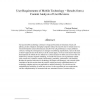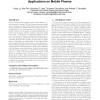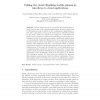127 search results - page 9 / 26 » Keystroke-level model for advanced mobile phone interaction |
101
click to vote
HCI
2007
15 years 1 months ago
2007
In this paper we present a procedure to learn a topological model of Situated Public Displays from data of people traveling between these displays. This model encompasses the dista...
121
click to vote
INFOCOM
2009
IEEE
15 years 7 months ago
2009
IEEE
—As mobile phones increasingly become the target of propagating malware, their use of direct pair-wise communication mechanisms, such as Bluetooth and WiFi, pose considerable cha...
113
click to vote
ISEM
2008
15 years 8 days ago
2008
Advanced mobile technology continues to shape professional environments. Smart cell phones, pocket computers and laptop computers reduce the need of users to remain close to a wir...
144
click to vote
MOBISYS
2009
ACM
16 years 24 days ago
2009
ACM
Top end mobile phones include a number of specialized (e.g., accelerometer, compass, GPS) and general purpose sensors (e.g., microphone, camera) that enable new people-centric sen...
121
click to vote
MIDDLEWARE
2009
Springer
15 years 6 months ago
2009
Springer
Mobile phones are set to become the universal interface to online services and cloud computing applications. However, using them for this purpose today is limited to two configura...



